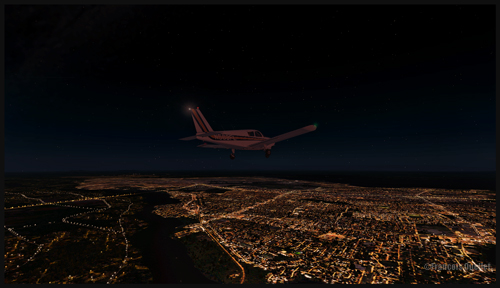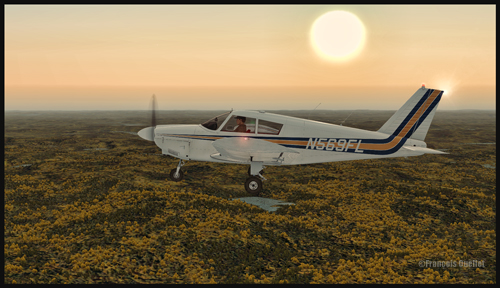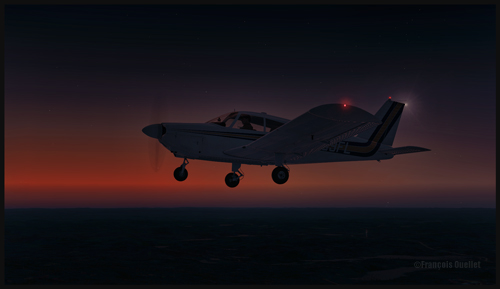(Precedent story: The Private pilot license)
Note: For this real story, since I did not have a camera with me in the aircraft in the 1980 flight, I reproduced the flight on a simulator using a Piper Cherokee (which is the closest I could find that looks like the Grumman Cheetah).
Shortly after obtaining my private pilot license, in 1980, I was asked to pick up a plane parked in Earlton, Ontario, three hundred nautical miles northwest of St-Jean-sur-Richelieu, and bring it back to St-Jean. To get to Earlton, I was in the company of an experienced pilot and we left together on a single-engine Grumman Cheetah. For the return flight, each pilot would fly his own plane, following one another. My companion would lead in his aircraft because he had all the necessary navigational charts to get us back to St-Jean.
Along the way we had to deal with a cold front which delayed our arrival to St-Jean. Before the journey started, I was assured that we would arrive before darkness. It now seemed a bit tight.
My companion had accelerated the pace. Two facts became obvious: first, the sunset was beautiful. Second, I did not have my night flying rating. This sunset meant that there was about thirty minutes left before total darkness.
I called him on the radio to enquire if he still believed that we would reach St-Jean on time. He answered that we were at the limit.
I then enquire about the possible existence of a button that would illuminate the instruments at night. The button was found and soon the instruments took on a pinkish color. Then came the questions about the essential tools for a night flight. He named the few.
With minutes passing by very quickly it now seemed impossible to arrive before the official night time as we had not yet crossed the Montreal Pierre-Elliott-Trudeau control zone.
Approaching Montreal, I tried to communicate with my companion but there was no more reply. The only navigational fix available for this improvised night flight was the small red rotating beacon on the tail of his aircraft. Strangely, its intensity was gradually weakening. My companion was getting away, his plane being a faster one.

I increased the power and adjusted the mixture to gain a few knots, while focusing on the little red dot that could direct me to St- Jean-sur-Richelieu. I was not too happy with my performance. I should have insisted from the beginning, to have a copy of all the documents. But this flight seemed so simple. Lesson learned.
We flew through the Montreal international airport control zone. In the night, the strobe lights of big airliners were visible on the approaches to landings or during take-offs. Abusing the engine a little bit, I gradually decreased the distance from my companion’s aircraft. Unable to hear anything due to the lack of documents that would provide the local frequencies being used, I simply followed the aircraft ahead of me.
Suddenly, the distant red beacon started going down in the night. I supposed we were getting close to St-Jean-sur-Richelieu. My companion was certainly communicating with the airport control tower to announce his intentions. This was a frequency I knew by heart. I ran the risk of calling him on the tower frequency to ask for tips to land at night. The answer was short and uncertain, because he knew that radio communications were recorded. The only advice he could find was: “I do not know what information to give you, take your time.” The air traffic controller heard this and offered me the presence of emergency vehicles, an offer I politely declined.
A Lake Buccaneer seaplane pilot flying in the area heard the communication and told the controller: “Advise him to turn his landing light on!” I replied that it was not functional. It had been observed during the pre-flight checks at St-Jean-sur-Richelieu, but it was not supposed to be a problem since we were flying during daytime only.
The first step towards a landing is to know the relative position of the plane from the airport and its three runways. When you have never flown at night, the view is different and requires an adjustment. Once the runway in use was identified (runway 11), the next step was to imagine that the flight instructor who trained me was sitting next to me. He would require good positions in the circuit, exact altitude according to each leg of the circuit pattern, appropriate speed and flap degrees, and finally an approach with a suitable angle.
At the time, all I knew about night flying boiled down to one eminently practical aspect: there was a wooded area at the beginning of runway 11 and I did not want to descend too much and hit the top of those trees, invisible in the night. However, being too high above the runway threshold would mean that the wheels would touch too far away past the threshold and the remaining runway length would be insufficient to stop the aircraft the ideal way, that is to say in one piece.
During the final leg of the approach, although my attention was fully dedicated to the procedures, I could feel that the rhythm of my heart had accelerated. On short final, everything happened quickly. The plane flew above the wooded area, the runway approached rapidly and the two wheels of the main gear touched the runway gently. The brakes were applied immediately and everything was over.
The main issue was now solved. I requested guidance from the air traffic controller to taxi down to the flying club. He jumped on the opportunity to ask me, a smile in his voice: “Are you going to take your night flying rating now?“!
(Next story: Night landing on an ice rink).
For other real life stories as a pilot, click on the following link: Real life stories as a pilot

